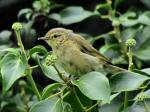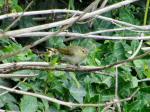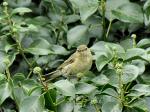| Willow Warblers |
| Latin name - Phylloscopus trochilus Willow Warblers are summer visitors, appearing in the UK from about late March or early April after having spent the winter in Africa, south of the Sahara; leaving again for Africa in September/October. Notoriously difficult to distinguish from the Chiffchaff I am indebted to members of the bird forum in Wild about Britain for their help in identifying these photographs. They are small birds with greenish-brown backs, pale under parts, yellowish chest and throat with a pale stripe above the eye (supercillium). Although the legs are often pale compared to the dark legs of the ChiffChaff, this is not an infallible guide as individual Willow Warblers can vary in leg colour from flesh coloured to dark brown. Other differences between the Chiffchaff and the Willow Warbler include the Willow warbler having longer primaries (extension of the flight feathers beyond the folded wing), a distinct eyebrow and a very different song. The Willow Warbler's song is a melodic rippling phrase that rises quickly before slowly dying away whilst the chiffchaff gets his name from his song which is a series of 'chiff' and 'chaff' notes but not in any particular order. Willow Warblers can be found in open woodland and scrub almost anywhere
in Britain. It feeds on insects and spiders and makes its domed nest
on or near the ground, hidden in shrubs or long grass. The nest has a
side entrance and the tiny eggs are incubated by the female alone although
the young are fed by both parents. Unusually for birds, they moult their
feathers twice a year, once here in their breeding grounds and again,
in Africa, whilst they are over-wintering. |
 |
 |
 |
 |
 |
 |
 |
 |
 |
 |
 |
 |